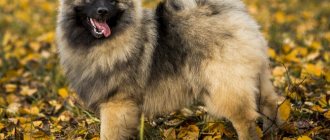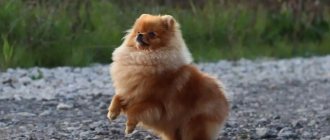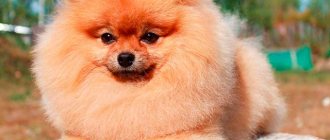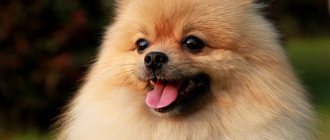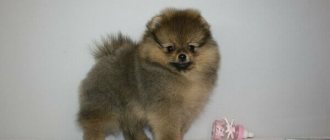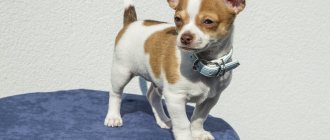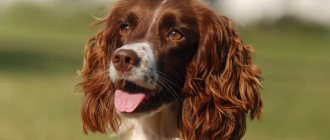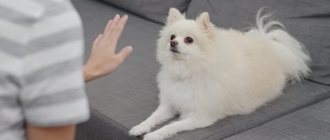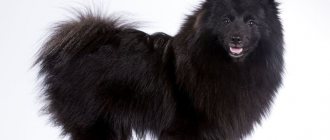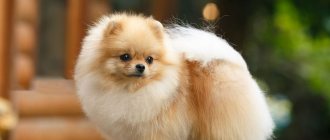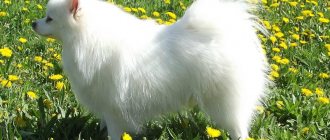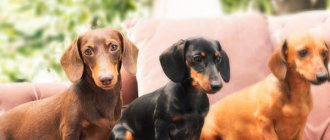5 / 5 ( 2 voices)
The Pomeranian is the smallest and most energetic member of the Spitz-type dog breed. Representatives of the breed are easy to train, affectionate and devoted to their owners, courageous, very sensitive, but sometimes they can annoy with uncontrollable barking for any reason. Decorative miniature dogs are loved by many; they are wonderful companions and loving pets. The Pomeranian is one of the twenty most popular dog breeds in the world.
The Pomeranian is one of our favorite dog breeds.
Origin story and what it looks like in the photo
The ancestors of the dwarf Pomeranian are the common German Spitz. In the mid-18th century, these were dogs that were approximately knee-high. And they also weighed a lot - from 14 to 23 kg.
People of that era were happy with just such large Spitz dogs, because they were not only reliable and devoted companions, but also guards.
The fashion for small dogs, which could be kept in boudoirs and carried in arms, began later - already in the 19th century. It was then that Queen Victoria personally began breeding a smaller copy of the German Spitz.
The ancestor of the Pomeranian Spitz, including the dwarf variety, was a dog named Marco, whose weight was 5.4 kg.
As a result of properly carried out breeding work, the size of Spitz dogs was almost halved by the end of Victoria’s reign.
True dwarf Pomeranians were bred in the mid-20th century..
It is assumed that the Spitz, which could well be called a pocket dog, originated in Japan, and that this was due to the fact that in Japanese cities apartments are very small.
So breeders have developed a new variety of oranges, which are particularly small in size and do not require a large living space.
List of suitable nicknames
Since Pomeranian “bear cubs” evoke a feeling of tenderness, they are often given affectionate and even funny nicknames:
- Donut/Pony, Funtik, Knopa, Tosha;
- Umka, Plusha, Lala.
These nicknames are suitable for both male and female puppies.
You can also name a dog based on its color. The following nicknames will be relevant for Pomeranians:
- Snowball, Mishutka, Ryzhik;
- Smoke/Smoke, Ember, Fog.
The fashion for exquisite foreign names is gaining momentum.
| For girls | For boys |
| Bianca | Mark |
| Giselle | Amadeus |
| Aurora | Bernard |
| Emilia | Wolf |
| Eve | Icarus |
| Monica | Askold |
| Juno | Hector |
| Bella | Marseilles |
| Daphne | |
| Amalia |
Separate breed or genetic marriage? What is the difference from the mini?
Dwarf Pomeranians are not allowed for exhibitions or breeding. And as adorable as they are, they should be considered a breed defect.
Dwarf Pomeranians are even smaller than the mini variety of this breed, weighing on average 1.7-1.9 kg .
Where can I buy
The breed is popular in Russia; in many cities there are nurseries that breed Spitz dogs. Among them are:
- Liebe Kinder (Ekaterinburg);
- Fire Fox (Kaluga);
- Mini Gum (Moscow);
- Bon Chanterelle (St. Petersburg).
The price of puppies may vary depending on the class of the pet. On average, a Pomeranian with all documents will cost 25,000 rubles. If you plan to purchase a show-class dog, the cost can rise to 100,000 rubles.
Whatever type of Spitz you like, you should remember that the dog’s behavior is primarily determined by upbringing and training. Therefore, any variety of the breed can become an excellent friend or family companion.
Dwarf Pomeranian Spitz
The Dwarf Pomeranian is a small, active and energetic dog, distinguished by intelligence, intelligence and playfulness.:
- Their body is square.
- The head is moderately convex, with a well-defined transition to a rather short, but not wide muzzle.
- The ears are small, erect, triangular in shape.
- The eyes are almond-shaped, dark brown. The look is lively, smart and friendly.
- The nose is black; in brown Spitz dogs it is brown.
- The neck is not too long, with a smooth transition to the withers. The back is flat, straight and rather short. The chest is of sufficient depth and volume. The belly is moderately adjusted.
- The forelimbs are level, straight and parallel. The hindquarters are moderately muscular and are pulled back somewhat when standing.
- The tail is in a ring or simply carried over the back in the form of a plume.
The wool is two-layer, consisting of a fairly strong, but at the same time elastic, outer coat and a very soft undercoat, which looks and feels like cotton wool.
The Dwarf Pomeranian should look compact, but not squat..
Pet character
Dwarf Pomeranians are distinguished by their cheerful disposition, playfulness and devotion to their owners . They cannot be called pampered or fragile: they are active and mobile pets who love to run and play.
They are quite smart and well trained. However, the Pomeranian does not always agree to carry out the owner’s commands, since with improper upbringing the dog grows up selfish, capricious and stubborn.
It is also very important that the pet is socialized, otherwise problems may arise later due to its aggressiveness towards other animals.
Despite the fact that the Dwarf Pomeranian Spitz is good with children, it is not one of the breeds whose representatives are kind to children's pranks.
These dogs hate being teased or made uncomfortable and, without hesitation, can snap at their offender or even bite.
Expert opinion
Kozhevin Semyon Kirillovich
Expert dog handler.
“A dwarf Pomeranian, which is the smallest in size of all Pomeranians. This variety is not officially recognized, but these dogs are very popular as pets. In addition to their charming appearance and thick, fluffy coat, they also have such positive qualities as a wonderful character, mobility and energy. Such pets are well trained, but only if from an early age the owner spared no time and effort on their upbringing and socialization.”
Spitz mixes
The last Pomeranian species is the most interesting because we will talk about mixes.
Designer breeds, as people call it when you cross two types of dogs from different breeds, are a controversial topic. Reputable breeders do not accept them because these mixed dogs do not strengthen the pedigree or improve the breed.
Mixed Pomeranians have traits from both breeds and can have a rather unique appearance. But this is precisely what makes them so popular and desirable.
Believe it or not, there are over 30 Pomeranian blends. Some of the most popular:
- Pomchi - Pomeranian and Chihuahua
- Bishonaran - Pomeranian and Bichon Frize
- Dameran Spitz and Dachshund
- Pomsky - Pomeranian Spitz and Husky
- Pomapoo - Pomeranian Spitz and Poodle
- Shiransky - Spitz and Shih Tzu
- Maltipom - Pomeranian and Maltese.
So, if you're wondering why your Pomeranian looks so much like one of these breeds, it might actually be a mixed dog. Unfortunately, you cannot tell how purebred your Pomeranian is without a DNA test.
Advantages and disadvantages
pros:
- Sweet and charming.
- They do not need a large living space.
- Energetic, agile and quite resilient.
- They are friendly and loyal to the owners.
- They love children, but you need to remember that only children over ten years old can play and communicate with such a pet.
- They willingly use a diaper or tray if they are accustomed to it.
- You can take them with you on any trip.
Minuses:
- If raised incorrectly, they can grow up stubborn, capricious and disobedient.
- If you cause them discomfort, they may snap or bite.
- They are not always friendly towards other animals.
- They are characterized by increased emotionality.
- If you don't teach them to be quiet in your house or apartment, they will bark constantly.
- Needs careful handling.
- They shed heavily.
- Dwarf Pomeranians with short snouts are prone to heart disease.
- Not allowed for exhibitions and breeding.
One of the main disadvantages is that you can buy a regular-sized dog under the guise of a dwarf orange.
Flaws
A Spitz is not suitable for families with small children - a dog that demands attention with its ringing bark can scare the child. In active games, a child can harm a mini dog. If a Spitz experiences pain, it may become aggressive towards children.
Very busy people will not be able to devote time to walking and caring for their dog. Howling and barking will not please the neighbors of a lonely Spitz. And a nervous dog can begin to spoil the things of a busy owner, which will cause an attack of indignation and conflict.
The cocky character of the dwarf Spitz does not allow him to run without a leash. Boys will provoke other dogs into fighting. Girls snap at strange dogs when they want to get to know each other.
The high cost of a dog and the large amount of time spent on care and training are also a deterrent to buying a puppy.
Types of dogs
There are three types of dwarf Pomeranians, differing from each other in the structure of the head, muzzle, ears and coat length.
"Bearish"
Bear-type dwarf Pomeranians look like teddy bears, which is often emphasized by their haircut. Their head is round and wide, and their muzzle is slightly upturned and very short.
Some "bear" type Spitz have a muzzle length that does not exceed a centimeter . The nose is large, the eyes are quite close-set, very dark and expressive.
Long and thick hair on the animal’s cheekbones creates the illusion that the dog’s cheeks are round and plump.
Currently, it is the dwarf oranges of the “bear” type that are especially popular.
This is not always to the benefit of the breed, especially when you consider that in the pursuit of a more endearing appearance of such dogs, their health is often sacrificed for the sake of fashion.
"Fox"
Fox-type Dwarf Pomeranians are similar to the classic German Spitz. With the shape of their head and rather long, narrow muzzle, they resemble small fluffy foxes.
Like other Pomeranians, they have a square body, but their paws and tail are longer than those of other representatives of the breed . The fur of “fox cubs” is average in length and fluffiness.
"Toy"
Spitz "toys" belong to the intermediate type. Their muzzles are longer than those of bear cubs, but shorter than those of foxes.
They got their name due to the fact that their eyes are quite widely spaced and set higher than those of “bear cubs”, which gives them a special, “doll-like” expression of the muzzle.
Appearance
Since, when describing the breed, it is customary to focus on international standards, the Pomeranian should be perceived as a variety of a large breed group. But that’s not all, if you talk to “breed breeders” and Spitz lovers, you will certainly hear the terms toy, mini, toy... If you do not have deep knowledge of cynology, you may be confused by misconceptions associated with dwarf breeds.
Initially, it is worth understanding that:
- The Pomeranian is already a mini variety, and when a breed is presented as a toy or super-mini, this is already an advertising ploy for selling puppies.
- The size of an adult Spitz dog can vary from 20 to 65 cm, and purebredness is determined by compliance with the requirements of the breed standard. That is, if Pomeranian Spitz puppies are offered for sale, then their parents must be miniature in size. Spitz dogs whose height is 40 cm at the withers cannot produce “Pomeranians,” no matter how similar or impressive the puppies look.
- All Spitz, regardless of variety, must meet the same FCI breed standard; otherwise, there is no point in pursuing an international show career.
- The weight of Spitz is not defined by the standard and must correspond to height while maintaining all the proportions that define the breed.
- If you want to choose a Pomeranian Spitz puppy for breeding work and a successful exhibition career, you need to take into account that dogs are divided by the type of face. Let us note that there are no official requirements for the type of muzzle in the standard and the exhibition score rather depends on the subjective opinion of the judge and the general proportions of the dog. According to “established norms,” the following types of breed are distinguished: Bear-type Pomeranian (Pomeranian) – the shape of the muzzle tends to be rectangular, the space under the eyes and cheeks are well filled. The optimal type of muzzle for a show Pomeranian dwarf Spitz (height at withers 18–22 cm).
- Fox-type Pomeranian (German) - wedge-shaped face, slightly pointed, medium-filled cheeks. This form is preferred if the dog is exhibited in the ring of small Spitz (height at the withers 23–29 cm).
- Toy type Pomeranian - similar to the bear type, but the muzzle is shorter. Another difference is the set of the eyes, higher and wider. Many experts consider this type to be a defect if the dog's face looks flattened or snub-nosed.
Basic colors
- White. The white dwarf orange should have a snow-white color. No extraneous shades in the form of darkening or yellowing of the coat are allowed.
- Black. A black Spitz should be pure black, with no brown, gray or reddish tints.
- Black and Tan . Jet-black base coat color, complemented by fawn or red markings located above the eyes, on the muzzle, ears, neck, chest, limbs and on the inside of the tail.
- Brown . Can be any of the brownish shades.
- Soboliny . The outer coat is zonally gray in color, and the undercoat is grayish, orange or cream.
- Ginger . It comes in different brightness and intensity: from golden to bright reddish-red. Also, dogs of orange color often have lightening of the fur on the inside of the paws, on the tail and on the neck.
- Cream . It may appear almost red or be difficult to distinguish from white.
- Zonal gray . The guard fur is darkened around the eyes, eyebrows, ears and tail. The undercoat is silver-gray. Due to this, an interesting effect of gradation of fur shades is created, making the orange look like a small wolf.
- Two-color . The main color of the coat is white. There are small markings on it in one of the three colors allowed by the standard: black, reddish or brown.
All other color variations, including merle, blue, tri-color and brown and tan, should be considered breeding grounds..
Life expectancy and health
Standard Pomeranians live 12-16 years, and the dwarf representative of this breed also has a chance of living to that age .
But only if the dog belongs to healthy breeds, and the owners take a responsible approach to keeping and feeding the pet.
These dogs may be susceptible to the following ailments::
- Tracheal collapse.
- Hypothyroidism
- Cardiovascular diseases
- Atlantoaccipital subluxation
- Dislocation of the knee or elbow joint
- Obesity
- Cryptorchidism
- Oral and dental diseases
- Cataract
- Entropion of the eyelids
The use of Pomeranian Spitz dogs with signs of dwarfism in breeding has led to the fact that in addition to general breed ailments, they can also suffer from specific diseases.
Such diseases include:
- Hypoglycemia
- Hydrocephalus
- Incomplete fusion of the skull bones
Dwarf oranges of the “bear” type with very short and flat muzzles also have breathing problems and are predisposed to respiratory diseases.
Reviews
Anna: “I often hear ridicule towards small decorative breeds, that they are stupid and will never replace a full-fledged dog. I was personally convinced that these were prejudices. My tiny bear is very smart and understands me perfectly.”
Svetlana: “I received my Spitz as a gift. At first it was very scary. He is so small and defenseless. However, now I know that such dogs are energetic and lively. Now I even let the dog out to play with other animals.”
Evgeniy: “My wife and I wanted to have a four-legged friend. Since we live in an apartment, we decided to adopt a Pomeranian. We prepared thoroughly: we studied the description of the breed, all possible diseases. We did not encounter any problems with the content. And most importantly, the grandchildren are delighted with the pet.”
Care and maintenance
The Dwarf Pomeranian needs to be brushed with a brush and a wide-tooth comb.
Normally this should be done once a week. But when a pet sheds, you will have to brush it at least daily.
You can bathe your dog no more than 2-3 times a year, and then only when necessary..
IMPORTANT!
Nowadays it has become fashionable to trim Spitz dogs, however, you need to take into account that you cannot cut them with a clipper, as you can easily ruin the hair.
It is recommended to examine your pet's ears and eyes daily . If necessary, clean the eyes with special products purchased at a veterinary pharmacy, first applying them to a cotton pad or swab. The ears are cleaned with cotton swabs.
Teeth are cleaned with treats or chew toys, or brushed with a dog toothbrush coated with a small amount of pet toothpaste..
Dwarf Pomeranians' nails should be trimmed approximately 1-2 times a month.
Feeding and diet
In the first two weeks after purchasing a pet, the puppy should be fed in accordance with the breeder's recommendations..
Only after the process of adapting the baby to the new home is completed, it will be possible to transfer him to the feeding option that is most suitable for the owner.
Due to the small size of the dwarf orange, it can be difficult to calculate the correct ratio of foods in its diet.
Therefore, most breeders and owners feed their dogs a ready-made complete super-premium or holistic food.
When feeding naturally, at least a third of the diet should consist of animal protein products: meat or offal. To them you need to add a little porridge, as well as cottage cheese, kefir or natural yogurt.
A dog’s diet cannot do without vegetables, which are fed to the Spitz both raw and cooked.
The number of feedings depends on the age of the pet: at first, while the puppy is small, he is fed 4-5 times, but by the age of one year he is gradually transferred to twice feeding.
How to choose?
You need to purchase such a pet with documents, from a nursery or from a breeder. At the same time, it is very important that the puppy is healthy himself and belongs to healthy lines.
It would also be useful to agree on an examination of the selected baby in the clinic before purchasing . As a rule, conscientious breeders have nothing against this, since they are confident in the health and quality of their dogs.
When choosing a baby in the litter, you also need to pay attention to how active and friendly he is.
NOTE!
A good dwarf orange puppy is quite active and playful, he is not afraid of people and willingly approaches them to get to know them.
At the time of sale, children must have received the age-appropriate vaccinations and undergo quarantine.
When buying white, black, and brown puppies, you need to keep in mind that their color should be as uniform as possible.
As for orange oranges, at an early age they often have a grayish coating, which will disappear over time.
Advantages of the breed
A sociable and loving pet will become a joy and motivator for active people. The micro-size of the dog will allow families to take the pet on all trips and travels. The sonorous barking of a dog will notify the owner of the approach of a stranger.
The Spitz will become a friend and companion for young people, and will also teach them to take care and show responsibility. Excellent natural immunity will allow the dog to live 15 years, full of joy and devotion to the owner. The attractive appearance of the Spitz will make passers-by smile and the owner be proud of his baby.
